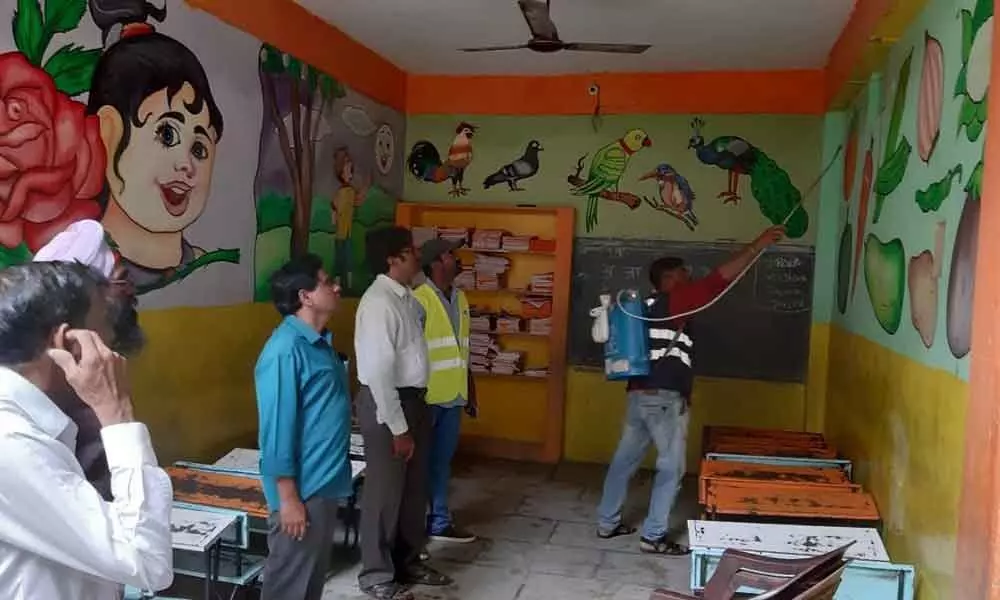Live
- Chanchalguda Jail Officials Say They Haven't Received Bail Papers Yet, Allu Arjun May Stay in Jail Tonight
- BJP leaders present evidence of illegal voters in Delhi, urge EC for swift action
- Exams will not be cancelled: BPSC chairman
- Nagesh Trophy: Karnataka, T.N win in Group A; Bihar, Rajasthan triumph in Group B
- YS Jagan condemns the arrest of Allu Arjun
- Economic and digital corridors to maritime connectivity, India and Italy building vision for future, says Italian Ambassador
- SMAT 2024: Patidar's heroics guide Madhya Pradesh to final after 13 years
- CCPA issues notices to 17 entities for violating direct selling rules
- Mamata expresses satisfaction over speedy conviction in minor girl rape-murder case
- Transparent Survey Process for Indiramma Housing Scheme Directed by District Collector
Just In
GHMC steps up drive against mosquitoes


In a recent survey conducted by GHMC on mosquitoes in the Greater Hyderabad, it was revealed that more than 60 per cent of mosquitoes in the city are of Culex type.
• 60 per cent of mosquitoes in the city are of Culex type, says its survey
• Sustained mosquito control efforts key to prevent outbreaks of diseases
Hyderabad: In a recent survey conducted by GHMC on mosquitoes in the Greater Hyderabad, it was revealed that more than 60 per cent of mosquitoes in the city are of Culex type.
The disease-causing viruses and parasites are carried by specific species of mosquitoes. The most prominent mosquito-borne diseases are transmitted by three genera of mosquitoes Aedes, Culex, and Anopheles.
Culex, a large group of mosquitoes also known as common house mosquitoes, are the principal vectors that spread the viruses that cause West Nile fever, St. Louis encephalitis, and Japanese encephalitis, as well as viral diseases of birds and horses. Culex mosquitoes can also transmit the parasitic disease lymphatic filariasis and the bacterial disease tularemia.
GHMC entomology department has been conducting survey of larva for the last three months near areas where seasonal diseases such as dengue and malaria are rampant. While most of the areas reported male Culex mosquitoes, which are harmless, some areas reported Aedes aegypti. It is the yellow fever mosquito that can spread dengue fever, chikungunya, Zika fever, Mayaro and yellow fever viruses, and other disease agents.
Culex mosquitoes feed at night on humans and animals and are found indoors and outdoors. Anopheles mosquitoes are best known for spreading malaria, although they can transmit other diseases. They are active between sunrise and sunset and can be found both indoors and outdoors. Surface-water habitats that become stagnant and enriched to support Culex larval development, such as swamps, marshes, bogs, rice fields, and pastures.
The survey has found that breeding of Culex is rampant in various circles of Khairatabad zone and GHMC has taken up several measures for preventing mosquitoes in the problematic areas.
Spraying of anti-larva chemicals, releasing of Gambusia fish in water bodies, dropping oil balls and spraying of anti-larva chemicals through drones were taken up. The survey reveals that Aedes aegypti mosquito breeds in stagnated water in tree pots, plates, old tyres and vacant plots, while Culex breeds mostly in sewerage water.
People's participation key
As it is found that Aedes aegypti mosquito bred mostly in the water stagnated in rich and middle-class houses, GHMC believes that the harmful mosquito can be controlled with the help of public participation. To raise awareness, GHMC has been conducting extensive awareness campaigns to inform people to remove stagnated water from tree pots and other items in their houses to prevent harmful mosquitoes. This apart, GHMC entomology department has been spraying anti-larva chemicals on sewerage lines to prevent breeding of Culex mosquitoes as this species can cause swine flu, filariasis and other diseases.
GHMC has been using 150 portable fogging machines, one for each municipal ward, 13 fogging machines fitted to vehicles, two for each zone, and 668 knapsack sprayers, one for each anti-larva spraying team, and 30 power sprayers, one for each circle.
About 2,300 entomology staff have been conducting fogging in 150 colonies per each day. GHMC is planning to double the fogging machines to 300 shortly. Due to the extensive mosquito prevention activities conducted by GHMC, a number of dengue positive cases witnessed drastic fall in the recent days. GHMC has also been focusing on preventing breeding of Anopheles mosquitoes apart from Culex.
GHMC has also started anti-larvae spraying at all the government schools its limits. Its officials are conducting awareness programmes at government schools on measures to be taken for prevention of mosquitoe breeding, and for observance of every Friday as dry day, filtering drinking water, keeping surroundings clean and other measures to prevent dengue and malaria.
Information regarding medical services being provided at major government hospitals, urban care centers, basti davakhanas and special health camps is also being provided to people. Drone technology is being used to spray anti-larvae chemicals on ponds, tanks and other bodies to prevent mosquitoes.

© 2024 Hyderabad Media House Limited/The Hans India. All rights reserved. Powered by hocalwire.com






